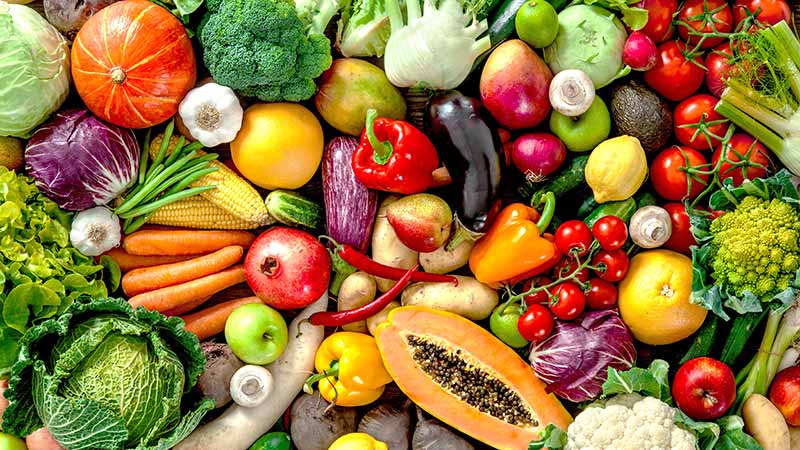
Can they actually be harmful? How much do we really need, what about taste and nutrition, and, did our ancestors even eat them?
Your mom may have told you to eat your fruits and vegetables, but many of these foods may be overrated. Let’s sort out the good, the bad and the ugly about these plant foods.
Thanks to modern agriculture, vegetables and fruits are now lower in nutrients, lack taste, higher in carbohydrates, and may produce abnormal signs and symptoms indicative of incompatibility. Personalizing is important, such as choosing those most nutrient-dense foods (spinach vs. green beans), skipping those higher in carbs (potatoes and corn) and most important, avoiding those that don’t agree with you.
We have heard for decades how almost all aspects of health will improve by eating more fruits and vegetables, yet most people eat very few. It’s sometimes even blamed for the global rise in chronic disease and excess body fat. But the real problem is that junk foods have displaced healthy fruits and vegetables in the diet.
There is no magic number of fruits and vegetables one should eat daily, although if there were most people would not approach it (and, we don’t need yet another government cookbook recommendation). If public health officials really wanted people to eat better, they would stop subsidizing junk food, tax it more, and reduce the cost of healthy foods. Money talks.
Instead, simple guidelines can help us make informed decisions based on personal needs.
A key reason for eating fruits and veggies is their supposed high nutrient content, important as we usually don’t eat like our ancestors did. They ate mostly fat and protein. Much of their vegetable intake was actually (as unsavory as this may seem) contained in the stomachs and small intestines of vegetarian animals and bugs they ate. Fruits as we know them did not exist. Choice animal cuts included bone marrow and brains, with liver, and other organs when fresh; these provided the many nutrients plant foods are now famous for (including vitamin C). Today, few people eat brains and bugs.
Due to dramatic modifications by agriculture scientists, our massively larger, sweeter and less nutritious plant foods are higher in carbohydrates, some non-digestible, and can cause intestinal bloating and discomfort, and inflammation, which can be body-wide. If increased ketone production is important, it’s key to consider how much absorbable carbohydrate comes from these foods (total carb minus dietary fiber). Many can even have more than the USDA database lists as these evaluations were performed decades ago, before these foods were tampered with by scientists. (In addition, polyunsaturated omega-6 vegetable oils like corn, canola, safflower, soy and others in particular can also promote inflammation.)
On paper, in order to obtain the many nutrients these foods have, or once had, we’d have to eat about six, eight or, some say, many more servings each day. Now the dilemma. With low-quality foods being the norm, can we obtain all our nutrients from them? Our food supply is already tainted enough so that we require dietary supplements to truly fulfill all our nutritional needs, (concentrating high-quality foods can accomplish this by removing water and carbohydrate/fibers).
Personalizing our eating habits is not difficult, something humans have always done. For example, seeing and smelling foods at the market gives our brains information about taste and desire. Experience too: If you love peppers but they don’t love you back, avoid them.
Speaking of peppers ripeness matters. Like other unripe foods, green peppers don’t digest well, typically producing gut discomfort. The process of ripening converts starch (polysaccharides), which is difficult to digest, to simple sugars. Many foods continue ripening after harvest, darkening or turning their natural color, but are picked unripe. Consider that bananas, limes, strawberries, melons, and sweet peppers do this. Imagine biting into a hard pale peach versus a soft bright ripe one. Likewise with tomatoes.
Plants are picked unripe with money in mind, including a longer shelf life and ease of shipping. Consumer’s pay for this with further reductions in nutrients and flavor. While we can usually ripen many fruits in a loosely closed brown paper bag at room temperature (plastic bags won’t work), the time from picking to eating is even further extended with more nutrient loss.
Organic fruits and vegetables are much lower in chemicals with potentially more nutrition. Poor growing practices, early picking, and increased storage times are still problematic.
Avoid the Ugly
The result of these problems are ugly fruits and veggies. They’re everywhere, leftovers called fresh, lingering on store shelves after a long journey from the farm (often from other countries). Some vitamins are unstable and lost during storage (although others are stable, including all the minerals).
While fresh is best, ugly foods are dead, a process that began the moment they were harvested, despite their fresh appearance maintained by cold temps, sprays and other tricks. Apples, for example, can be stored for a year or more after harvest (and taste like it) being chlorine-cleaned and waxed — with lettuce (up to a month), tomatoes (up to six weeks), carrots (up to nine months), and others taking their time to get to our tables.
Do we buy fresh, frozen or canned? When reasonably fresh options are unavailable, choosing other options might include frozen and canned.
- Frozen foods can sometimes be more nutritious as they tend to be picked ripe with little spoilage. Freezing your own fresh items is also a cost-effective alternative, which can keep much of the flavor. When foods are at their peak of the season, many can be frozen in bags as is. Berries, tomatoes and most other plant foods freeze well whole, with apples and others best cut up first. Use in smoothies or in recipes.
- Buying some canned items (jar or carton) may be acceptable too, but read the ingredients — no surprise that sugar often rears its ugly head. In addition to black olives, pickles and sauerkraut, tomatoes are the most common. Look for organic, whole tomatoes, most of these are picked ripe. Of course, canning at home is an option, but freezing is usually faster and cheaper.
To find out if fruits and veggies might be unhealthy for you, consider performing the Two-Week Test without them. If you’re eating well but still have abnormal signs and symptoms, you can eliminate plant foods for a couple of weeks to see if you feel better. Then carefully add select foods to your menu to see if symptoms return.
Choosing Wisely
Consumers face a difficult challenge — choosing to eat low-quality flavorless fruits and veggies, or avoiding them. The latter is not a bad choice if the food does not offer a return in enjoyment and nutrition. Adding flavor to veggies is also easy by preparing them with healthy fats, such as extra virgin olive oil, butter, coconut oil and others, and salt.
A recent presentation at the American Heart Association conference reported on the numbers of people who have a genetic sensitivity to bitter tastes, making veggies less appealing. Unfortunately, they forgot to mention that sugar-taste preference causes sugar-addicted people to dislike all foods that are not sweet, the main reason people use sugar in coffee. Hence, the habit of sweetening tomato sauce, fruits, and other natural foods (an absurd suggestion also made by one of the authors who presented at the heart association event). Sugar has long become the primary spice in food prep and home cooking.
And let’s not forget herbs and spices — powerful plant foods that play a key role in health. They include oregano, basil, mint, cinnamon, and also ginger, turmeric, garlic and red chilies. In addition, sprouts are easy to grow at home, with the most nutritious being two- to three-day-old broccoli sprouts.
Moreover, many of the most nutritious parts of plants are often thrown away: apple skins, the skins and whites of citrus, and the inner whites of ripe sweet peppers — these are much more nutritious than the rest of the plant.
I’m not backing down on my decades old recommendation of eating a wide variety of fruits and veggies as part of a healthy plant-based natural diet, but am emphasizing a caveat: Choose them wisely!
This article is an addendum to Plant Food Update which highlighted the various spectrum of healthy plant foods beyond fruits and vegetables, the definition of “serving,” and other issues.








